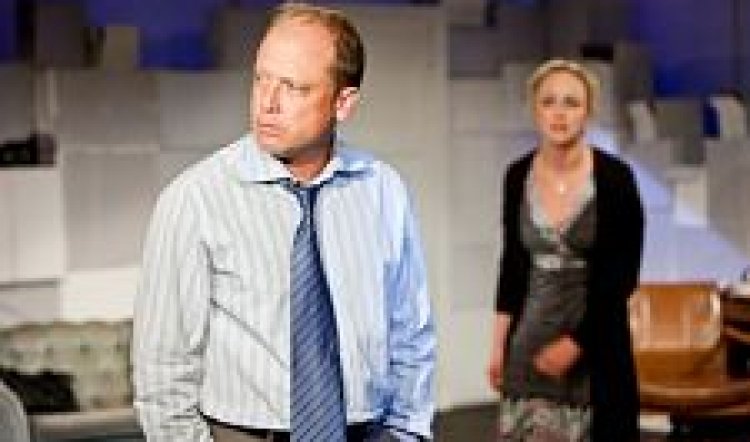
Shining City
Shining City, an Inside Job Productions and Griffin Independent at the SBW Stables Theatre; 25 November-19 December 2009.
REVIEWS by Michael Billington (Guardian) in 2004 and Ben Brantley (New York Times) in 2006 indicate that Conor McPherson’s play is better than this so-so Sydney premiere production. In New York Shining City – McPherson’s ninth published/produced work – was nominated for a Best Play Tony and had already been highly praised by critics in the UK, other than Billington. According to the Sydney producers’ blurb, McPherson (born 1971) is “one of Ireland’s most celebrated contemporary playwrights”. Ten minutes’ Googling him and his work reveals this isn’t a minority opinion. His track record in Dublin, and latterly, in London and New York, as writer and director, is enviable; so you have to suspect it’s not the play that’s the problem. Why then did its approximately 95 minutes feel so much longer on opening night at the Stables?
Shining City is set in the Dublin consulting room of a newly qualified therapist, Ian (Alan Dukes). His first client, John, (Laurence Coy) is only there because John’s first choice didn’t have a free appointment for some months – he tells the hapless Ian. John is a decent, middle-aged sales rep whose wife has recently died in a car accident. He is grief- and guilt-racked; more than that however, he believes the house they shared is haunted by her, to the extent that he’s moved out to a local B&B.
As a therapist, Ian is perhaps typical in that he has unquiet demons of his own (he’s recently left the priesthood; he has abandoned his girlfriend and their child) but he does answer the vital question, “you do believe me, don’t you?” in the affirmative; so the client/therapist relationship is able to continue and permit the play. It also allows John’s central confessional-monologue to happen and, by various digressions, we also get to learn a little more about Ian too. That learning occurs through the all too brief appearances of Caroline Craig, as his ex-partner, and Ben Geurens as a late night pick-up who, unlike his customer, has no visible Catholic guilt about how he makes a bit of ready cash.
(Generalising wildly), 20th century Irish theatre is either poetically garrulous – Martin McDonough’s Leenane Trilogy for instance, or the other end of the spectrum: pauses-and-fragments (Beckett). McPherson’s language is somewhere between the two. Yet like those two writers, the everyday, and the fashioning of compelling drama out of not very much also fascinate him. The thing about mundane, however, is that it has to be handled very well by actors and director alike if it is not to end up being, well, mundane. (See Julie Forsyth in Happy Days to understand how apparently mundane inanity becomes transcendent in the hands of a great actor.)
Coy and Dukes are both good actors, but they don’t seem at ease with their surroundings or fully in touch with their characters. To achieve the vital rhythm and flow necessary to make fragmentary dialogue and pauses unselfconscious, the performers must be so highly conscious – of each other and what they’re doing – that their effort appears effortless and the seams between conscious and unselfconscious become invisible. To do this the actors must be able to rely fully on directions and setting – the safety net that enables them to make the leaps of faith.
Unfortunately, director Nicholas Pollock and designer Ailsa Paterson seem not to have fully grasped nor dealt with the famous peculiarities of the Stables space; nor put into it a set design that does anything but hinder the actors, on the one hand, and work against the play, on the other. The result is the unnerving sight of actors marooned in the middle of nowhere without a map or compass. And as the play is about rootlessness the loneliness of crowds and the inadequacy of most human communication, it’s a bit disastrous.

The central scene (and problem in this production) is John’s lengthy monologue which is addressed to Ian whose only task, as therapist, is to listen, nod sympathetically, and let him get on with it. John sits throughout facing the audience, Ian also sits, facing his client, and consequently his back view is all that’s available to most in the bleachers. Visually and dramatically it’s duller than Dublin on a wet Wednesday.
Turn it about: have Ian sitting at his desk (upstage right) facing his client (and the paying public); and put John centre downstage where, in his natural – and written – agitation, it would be logical for him to at least occasionally move about the room/stage. It would inject some visual and dramatic interest into what is presented here as a static and unforgiving slab of text and back of therapist’s head.
The set, too, is prisoner to a single moment – albeit a crucial one, of which nothing more should be said because it really is a ripper coup de theatre. Designer Ailsa Paterson has created a stylized white walled office of stacked “cardboard” document boxes. These signify Ian’s recent move into the premises but do not conjure ideas of dingy Dublin rooms as the play requires; rather, it’s almost “edgy” Sydney and it causes a visual stoush between the elderly furnishings and their white surroundings, which is an unnecessary distraction.
In their supporting roles both Caroline Craig and Ben Geurens have the measure of what they’re doing and are excellent, but as already said, are not around for long. Vocal coach Gabrielle Rogers has also made a strong contribution: each member of the cast has an effortless and anchored soft, Dublin accent. And an alternately moody and authentic city soundscape by Jeremy Silver is another well-crafted element. Nevertheless, Dukes and Coy struggle to give three-dimensional shape and genuine emotion to characters and a situation that promised much. Perhaps time will tell a different story.



